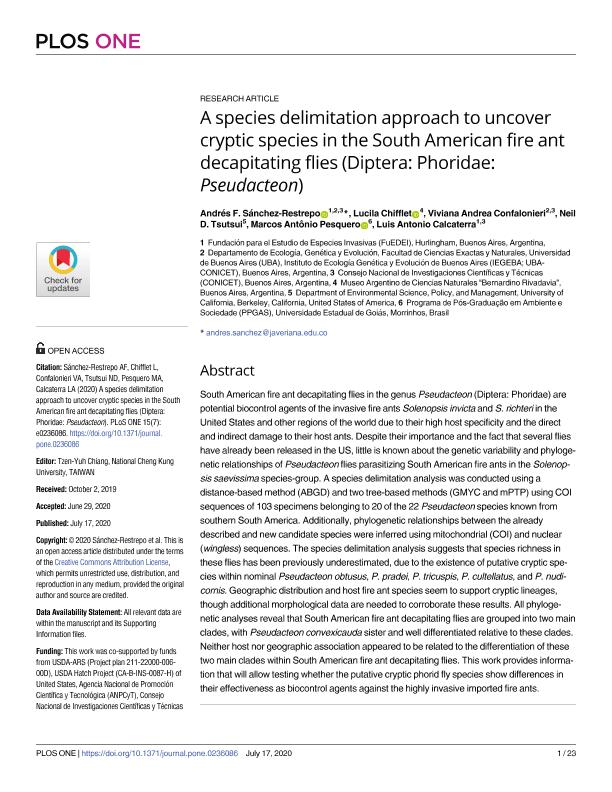Mostrar el registro sencillo del ítem
dc.contributor.author
Sánchez Restrepo, Andrés Fernando

dc.contributor.author
Chifflet, Lucila

dc.contributor.author
Confalonieri, Viviana Andrea

dc.contributor.author
Tsutsui, Neil D.
dc.contributor.author
Pesquero, Marcos Antônio
dc.contributor.author
Calcaterra, Luis Alberto

dc.date.available
2022-05-09T17:04:39Z
dc.date.issued
2020-07
dc.identifier.citation
Sánchez Restrepo, Andrés Fernando; Chifflet, Lucila; Confalonieri, Viviana Andrea; Tsutsui, Neil D.; Pesquero, Marcos Antônio; et al.; A species delimitation approach to uncover cryptic species in the South American fire ant decapitating flies (Diptera: Phoridae: Pseudacteon); Public Library of Science; Plos One; 15; 7; 7-2020; 1-23
dc.identifier.issn
1932-6203
dc.identifier.uri
http://hdl.handle.net/11336/156950
dc.description.abstract
South American fire ant decapitating flies in the genus Pseudacteon (Diptera: Phoridae) are potential biocontrol agents of the invasive fire ants Solenopsis invicta and S. richteri in the United States and other regions of the world due to their high host specificity and the direct and indirect damage to their host ants. Despite their importance and the fact that several flies have already been released in the US, little is known about the genetic variability and phylogenetic relationships of Pseudacteon flies parasitizing South American fire ants in the Solenopsis saevissima species-group. A species delimitation analysis was conducted using a distance-based method (ABGD) and two tree-based methods (GMYC and mPTP) using COI sequences of 103 specimens belonging to 20 of the 22 Pseudacteon species known from southern South America. Additionally, phylogenetic relationships between the already described and new candidate species were inferred using mitochondrial (COI) and nuclear (wingless) sequences. The species delimitation analysis suggests that species richness in these flies has been previously underestimated, due to the existence of putative cryptic species within nominal Pseudacteon obtusus, P. pradei, P. tricuspis, P. cultellatus, and P. nudicornis. Geographic distribution and host fire ant species seem to support cryptic lineages, though additional morphological data are needed to corroborate these results. All phylogenetic analyses reveal that South American fire ant decapitating flies are grouped into two main clades, with Pseudacteon convexicauda sister and well differentiated relative to these clades. Neither host nor geographic association appeared to be related to the differentiation of these two main clades within South American fire ant decapitating flies. This work provides information that will allow testing whether the putative cryptic phorid fly species show differences in their effectiveness as biocontrol agents against the highly invasive imported fire ants.
dc.format
application/pdf
dc.language.iso
eng
dc.publisher
Public Library of Science

dc.rights
info:eu-repo/semantics/openAccess
dc.rights.uri
https://creativecommons.org/licenses/by/2.5/ar/
dc.subject
INTRODUCED FIRE ANTS
dc.subject
PARASITOID FLIES
dc.subject
HOST SPECIFICITY
dc.subject
BIOLOGICAL CONTROL AGENTS
dc.subject.classification
Zoología, Ornitología, Entomología, Etología

dc.subject.classification
Ciencias Biológicas

dc.subject.classification
CIENCIAS NATURALES Y EXACTAS

dc.title
A species delimitation approach to uncover cryptic species in the South American fire ant decapitating flies (Diptera: Phoridae: Pseudacteon)
dc.type
info:eu-repo/semantics/article
dc.type
info:ar-repo/semantics/artículo
dc.type
info:eu-repo/semantics/publishedVersion
dc.date.updated
2022-05-02T17:15:32Z
dc.journal.volume
15
dc.journal.number
7
dc.journal.pagination
1-23
dc.journal.pais
Estados Unidos

dc.journal.ciudad
San Francisco
dc.description.fil
Fil: Sánchez Restrepo, Andrés Fernando. Consejo Nacional de Investigaciones Científicas y Técnicas. Oficina de Coordinación Administrativa Ciudad Universitaria. Instituto de Ecología, Genética y Evolución de Buenos Aires. Universidad de Buenos Aires. Facultad de Ciencias Exactas y Naturales. Instituto de Ecología, Genética y Evolución de Buenos Aires; Argentina. Fundación para el Estudio de Especies Invasivas; Argentina
dc.description.fil
Fil: Chifflet, Lucila. Consejo Nacional de Investigaciones Científicas y Técnicas. Oficina de Coordinación Administrativa Parque Centenario. Museo Argentino de Ciencias Naturales "Bernardino Rivadavia"; Argentina
dc.description.fil
Fil: Confalonieri, Viviana Andrea. Consejo Nacional de Investigaciones Científicas y Técnicas. Oficina de Coordinación Administrativa Ciudad Universitaria. Instituto de Ecología, Genética y Evolución de Buenos Aires. Universidad de Buenos Aires. Facultad de Ciencias Exactas y Naturales. Instituto de Ecología, Genética y Evolución de Buenos Aires; Argentina
dc.description.fil
Fil: Tsutsui, Neil D.. University of California at Berkeley; Estados Unidos
dc.description.fil
Fil: Pesquero, Marcos Antônio. Universidade Federal de Goiás; Brasil
dc.description.fil
Fil: Calcaterra, Luis Alberto. Consejo Nacional de Investigaciones Científicas y Técnicas; Argentina. Fundación para el Estudio de Especies Invasivas; Argentina
dc.journal.title
Plos One

dc.relation.alternativeid
info:eu-repo/semantics/altIdentifier/doi/http://dx.doi.org/10.1371/journal.pone.0236086
dc.relation.alternativeid
info:eu-repo/semantics/altIdentifier/url/https://journals.plos.org/plosone/article?id=10.1371/journal.pone.0236086
Archivos asociados
